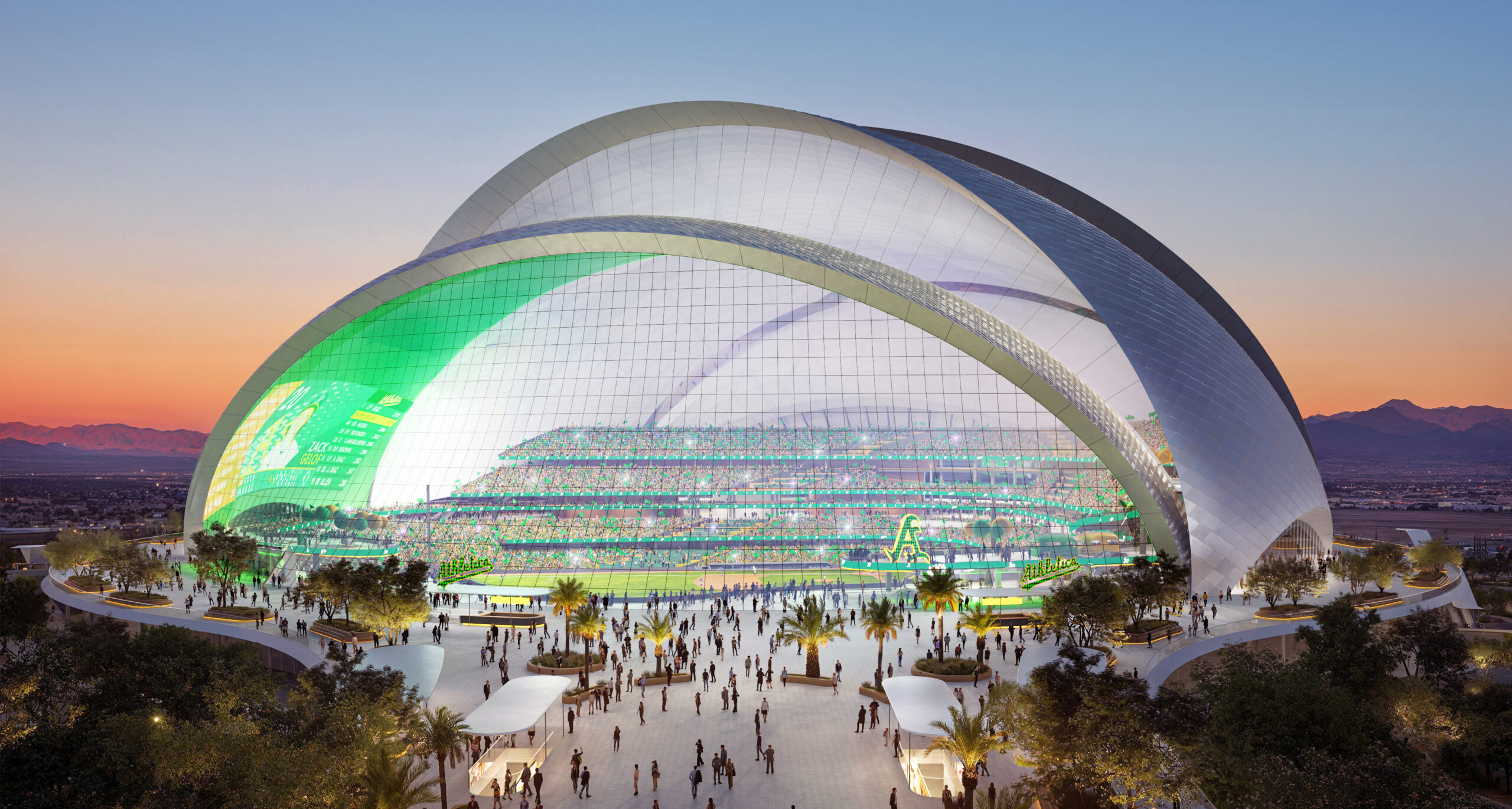A’s stadium plan includes a non-retractable roof, baseball’s largest jumbotron

The Oakland Athletics released four renderings of the Major League Baseball club’s planned $1.5 billion stadium Tuesday, and it appears the team is replacing the 67-year-old Rat Pack-era Tropicana Las Vegas with something akin to Australia’s Sydney Opera House.
The architect whose firm designed the 33,000-seat ballpark described its non-retractable roof as a “spherical armadillo.” In a statement, the designers said the stadium “provides an outdoor feel with views of the Strip.”
The renderings, which come after the team said drawings made public last year were no longer valid and three months after new plans were originally set to be unveiled, were released ahead of this weekend’s spring training games with the Milwaukee Brewers at the Triple-A Las Vegas Ballpark in Summerlin. The team plans to begin construction of the stadium next year and will officially relocate to Las Vegas for the start of the 2028 season.
The team initially hoped to install a retractable roof stadium on the site, but in an interview with The Nevada Independent, A’s owner John Fisher said the decision to create a non-retractable roof would allow the stadium to be used year-round for other events.
“We want a building that is alive and active,” Fisher said. “That’s our goal. We have an incredible location and given that there are so many people on the Strip every day of the year, we want to be able to provide an attraction for them. It’s very much a creative force.”
Fisher said the modified design did not change the anticipated stadium cost. He said naming rights to the stadium would be sold at some point ahead of its opening.
The ballpark is expected to fit on 9 acres of the 35-acre site housing the Tropicana. Bally’s Corp., which operates the resort, plans to close the property April 2 with plans to demolish the structure later this year.
The renderings show a 2- to 3-acre plaza area that extends from the Strip to the ballpark’s main concourse. The ballpark plan calls for 2,500 on-site parking spots.
The renderings are the second set of designs for the stadium released by the A’s. Three initial renderings showing the stadium with a retractable roof were released last May when the team was lobbying state lawmakers to provide $380 million in public financing to help pay for the ballpark.
After the financing package was approved, the A’s said the original renderings were no longer valid because they were just used to give lawmakers and the media an idea of what the stadium’s design might entail. Stadium experts said the 9-acre site was too small for a retractable roof.
Bjarke Ingels, the creative director of Bjarke Ingels Group, the Danish architectural firm that created the design in partnership with contracting firm HNTB, called the roof “five pennant arches” that will enclose the ballpark, shading the stadium from any direct sunlight.
“A giant window frames a majestic view of the life of the Strip,” he said. “All direct sunlight is blocked, while all the soft daylight is allowed to wash the field in natural light.”


According to the developers, the outfield features the world’s largest cable-net glass window (a structural system using pre-tensioned cable) facing the corner of Tropicana Boulevard and the Strip.
Fisher said the decision to go with a closed roof was made for comfort. He said in looking at retractable roof ballparks, most remain closed the majority of the time, adding that the large outfield window and other window openings will allow for large amounts of indirect sunlight into the ballpark.
“The most important thing here was fan comfort,” Fisher said. “But we also wanted to create a stadium that felt like you were outdoors to the best extent possible.”
He said Major League Baseball officials have seen the designs and were assured direct sunlight would not affect the home plate area, which was a concern raised by the initial renderings.
The ballpark is designed to include an 18,000-square-foot jumbotron, which would make it the largest screen in Major League Baseball.
Fisher said in January he wanted Bally’s to provide conceptual designs of what the casino operator would build to replace the Tropicana. However, the renderings do not include any additional buildings, such as a hotel-casino or restaurant and retail concepts.
He said the development is being viewed as a “collaborative space” with Bally’s given that it would attract both baseball fans and casino goers. Fisher said whatever Bally’s decides to build will not be in front of the large window, blocking views of the Strip.
“The A's have created a remarkable design that adds to the rich fabric of must-see attractions in Las Vegas,” Bally’s Chairman Soo Kim said in a statement. “This is a once-in-a-generation project, and we are thrilled for the opportunity to develop a comprehensive site plan at this iconic location. We look forward to sharing more on our plan in due course.”
Updated at 3:19 pm on 3/5/2024 to include comments from John Fisher.
